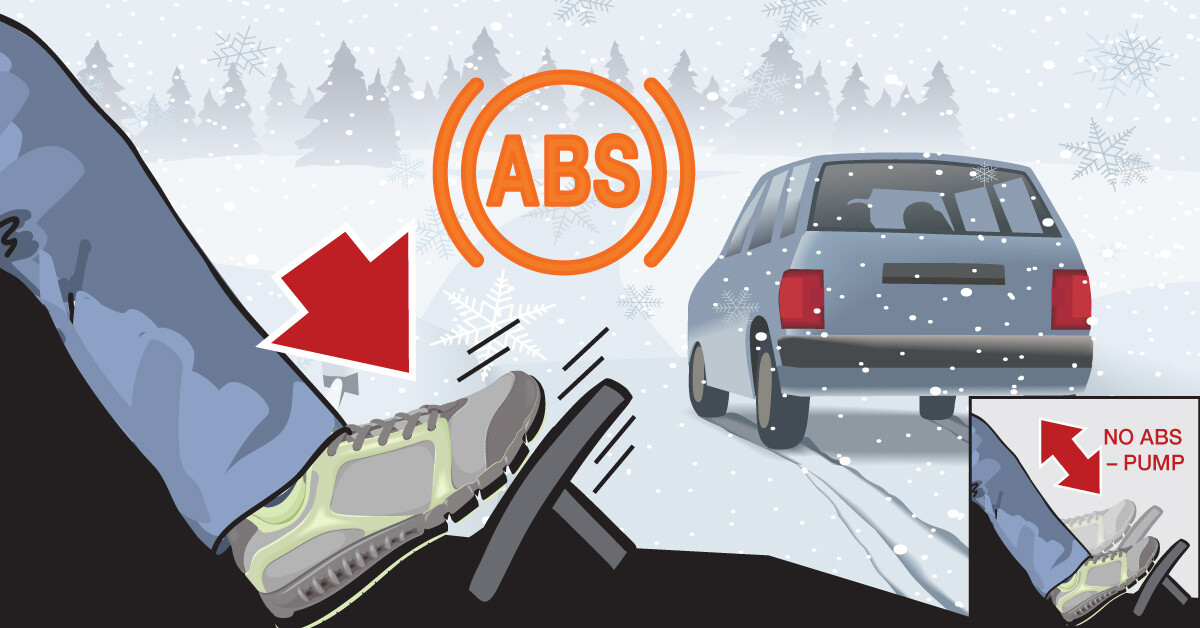Posted on January 31st, 2017
Breaking Down Anti-Lock Brakes

Depending on the year you learned to drive, you may have learned how to brake ion slippery roads one of two ways:
- A) Pump the brake, or B) hold the brake down firmly.
The correct answer depends on whether the car you’re driving has an anti-lock braking system, or ABS. It’s a safety system that pulses the brakes many times per second so that they don’t lock up. When the brakes don’t’ lock up, you are able to control the steering better.
Drivers who learned to drive before ABS became standard likely learned to pump the brake pedal during emergencies and slippery conditions. ABS takes away this requirement; but some who learned the pump method may question the need for ABS.
The National Highway Traffic Safety Administration (NHTSA) made ABS a mandatory feature for new cars starting September 2011. ABS provides driver more control through steering during braking by not locking the brakes.
Unless you live in a snowy and icy state, you seldom will get to feel ABS activate. When it does, it vibrates and groans. Drivers report that they feel like their brakes have failed. The vibration you feel is just the brakes pulsing the brakes many times a second.
How does ABS make you safer than just pumping the brakes on your own? What’s going on when your car’s ABS activates? Read further for answers to these questions and more.
What’s the secret behind anti-lock brakes?
When it comes to explaining the power of ABS, NHTSA says it best in a 2013 “Question and Answer” document:
“When faced with a panic braking situation, ABS allows a driver to rapidly apply the brakes without worrying about wheel lockup, and the vehicle begins to stop immediately. Without ABS, a rapid, hard brake application could cause wheel lockup and loss of vehicle steering control, if the driver does not pump the brakes correctly or limit the brake pedal force to prevent wheel lockup. Therefore, more driver skill is needed to obtain short stops without ABS.”
So, ABS can pump faster than a driver can, but how?
Simply put: Physics, modern computing and a whole lot of “oomph.”
When ABS is working properly, the driver may feel the brake pedal suddenly drop, followed by a rapid pulsing sensation. There may be a grinding or buzzing noise coming from the vehicle during the period ABS is activated. It may also feel like the brake pedal is pushing back when ABS activates.
ABS: The brakes that help you steer
You read that right – ABS is not just about braking, it’s also about steering.
In fact, steering is the primary safety function of ABS during emergencies, according to NHTSA:
“[Question:] Do cars with ABS stop more quickly than cars without? [Answer:] Perhaps, but that’s not the main purpose of ABS. It is a system designed to help you maintain control of the vehicle during emergency braking situations, not necessarily make the car stop more quickly.”
According to the Insurance Institute for Highway Safety (IIHS), on very slippery surfaces ABS can actually increase a driver’s stopping distance. These include surfaces with loose gravel or lightly packed snow. These materials can create a “dam effect” in front of the wheels that are locked up, preventing the vehicle from stopping as quickly as a vehicle without ABS would.
A literal lifesaver in a pinch
According to Liberty Mutual, by 2004 ABS was considered the second most important car safety feature after the safety belt. Other modern safety features – such as electronic stability control and automatic emergency braking – may eventually also rise to near the top of the list; but the lengthy history of ABS makes it a legend in the realm of car safety technology.
One of the most extensive studies of the life-saving benefits of ABS was a NHTSA study published in 2009. NHTSA analyzed crash data from 1995 to 2007, a 12-year period after which NHTSA conducted a large public information campaign on using ABS properly. ABS also came to be available as a standard or optional feature most new vehicles sold in the United States during this time.
According to the study, between 1995 to 2007:
- Anti-lock braking systems reduced the number of crashes among passenger cars by about 6 percent and by 8 percent for light trucks and vans.
- Anti-lock braking systems were especially beneficial on wet roads, reducing wet-road collisions by 12 percent among passenger vehicles.
- Fatal crashes between passenger vehicles with ABS and pedestrians, bicyclists and animals decreased 13 to 14 percent.
Getting to know your ABS
In 2017, most cars on the road have ABS. To check, turn your car to the accessory mode and see if the there is an ABS icon. If it’s there, your car has ABS.
All drivers should really get to know their ABS and understand how it works and what’s happening when it’s activated.





 Morgan Price
Morgan Price